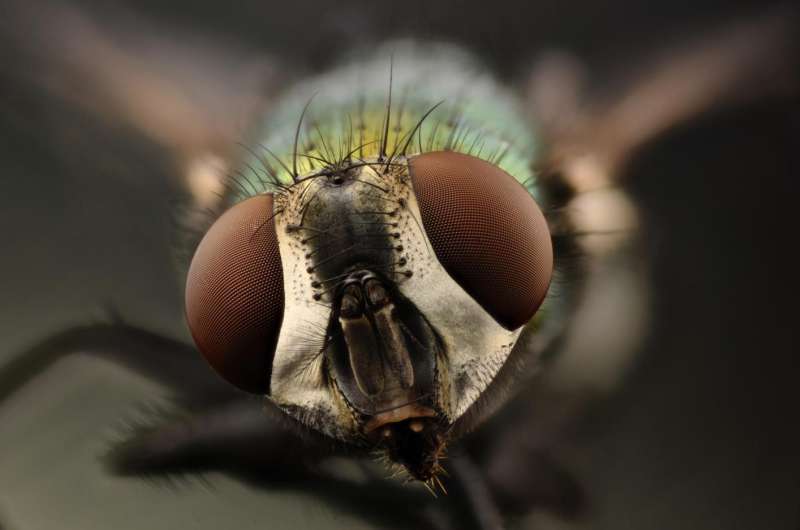Dating on the fly—female flies are attractive to mates on sunny days

Female green bottle flies attract potential mates by flashing sunlight at particular frequencies from their wings, according to research published in the open access journal, BMC Biology.
Dr. Gerhard Gries, the corresponding author, from Simon Fraser University, Canada, said: "Our study describes a new model of sexual communication in insects, which might be common to animals in general. By modulating wing beat frequency, and thus light flash frequency, the flies effectively communicate to their peers their sex, age, and possibly even mating status. Using video technology to capture and measure wing flash frequency we were able to show that male flies are attracted to specific flash frequencies and not the morphological characteristics of the female flies."
Males are strongly attracted to a wing flash frequency of 178Hz, which is characteristic of free flying young females, rather than 212, 235 or 266Hz, which are characteristic of young males, old females and old males, respectively. The slower wing flash frequency of young females could be a phenotypic trait of reproductively capable females, according to the researchers.
Flies have some of the most elaborate visual systems in the Insecta, with fast visual processing, which was thought to have evolved to match their advanced flight abilities. Males have larger eyes than females, which may help males perceive visual signals sent by females, and they have specialized 'bright zones' that increase light capture and can help them to detect females' flashing light signals. This study shows that the design and processing speed of the flies' compound eyes might also play a key role in mate recognition, as well as to support flies' agile flight and maneuverability.
The researchers filmed young and old male and female flies in free flight, filming 100 flies at a time within a wire mesh cage. They also took photographs and filmed outdoors so comparisons could be made between wing flash in direct sunlight and under a cloudy sky. The video recordings revealed that light flashes were not evident under diffuse light or outdoors under a cloudy sky.
Dr. Gries adds: "We found that on cloudy days, light flashes from the wings of flying females cannot be seen, which might help explain the low mating activity of these flies on cloudy days. This suggests that flies can apparently synchronize sexual communication with environmental conditions to optimize the conspicuousness of their sexual communication signals."
Male flies were also found to be attracted to LEDs that pulsed light at a frequency that imitates the wing flash frequency of prospective mates, suggesting that it is light flash frequency, rather than the morphological characteristics of the female flies that forms the mate recognition signal. According to the researchers, the ability to distinguish between different light flash frequencies suggests that green bottle flies have numerical competence even approaching the level of mammals, birds and fish.
In this study, the researchers mounted two live females side by side; only one had fully functional wings, while the other's wings were immobilized. Males preferred the female with functional wings showing that wing movement contributed to mate selection.
Dr. Gries said: "We can now study how widespread this phenomenon is in other flies, or insects. Our findings can also be incorporated into developing more effective methods for attraction and trapping of nuisance flies in urban environments."
More information: Courtney Eichorn et al. How flies are flirting on the fly, BMC Biology (2017). DOI: 10.1186/s12915-016-0342-6
Journal information: BMC Biology
Provided by BioMed Central




















